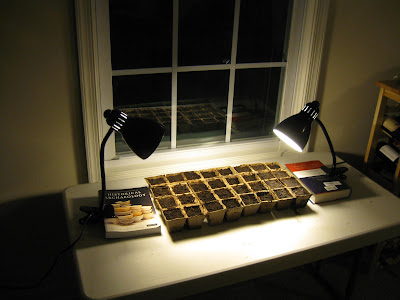It is formally spring this week, but the weather outside doesn't seem to have heard! We had one of the heaviest snowfalls of the year yesterday, covering the garden a thick, fluffy layer of white. I hope that won't hurt the seeds I planted last week, but if it does I will just replant. I am hoping this is the end of cold!
White it has been snowing outside, seedlings inside are coming along!
Fenugreek has been under cultivation for thousands of years and no one is really certain of when or where it originated. It probably comes from the Middle East, but is found throughout the ancient world. While its popularity has waned in recent times, fenugreek is a versatile plant, useful as an herb, spice, vegetable, and medicine. It remains popular in Indian and other Asian cuisines. It has been used in ancient times, the 19th century, and even today as a supplement to increase lactation in nursing women.
 All five varieties of tomato are coming along. Some are bigger than others, but I think I will have some plants of each type to put in the garden in May. Friends are clamoring for some tasty and unusual tomatoes, so I am hoping that the tomato crop won't meet with disaster like last year! There is nothing like a fresh garden tomato right off the vine!
All five varieties of tomato are coming along. Some are bigger than others, but I think I will have some plants of each type to put in the garden in May. Friends are clamoring for some tasty and unusual tomatoes, so I am hoping that the tomato crop won't meet with disaster like last year! There is nothing like a fresh garden tomato right off the vine! Valerian is just beginning to poke its head above ground. It's too soon to tell how well it will do, but I am hoping that, like fenugreek, I will have more success with it this year.
Valerian is just beginning to poke its head above ground. It's too soon to tell how well it will do, but I am hoping that, like fenugreek, I will have more success with it this year.Also like fenugreek, Valerian is an ancient medicinal plant. As I have written before, Valerian has been used to promote relaxation and relieve insomnia and anxiety for more than two thousand years. Both Hippocrates and Galen specifically mention Valerian in their writings.

















